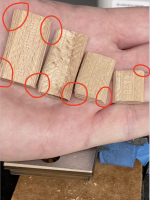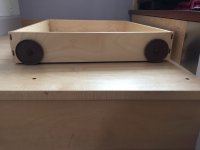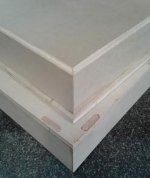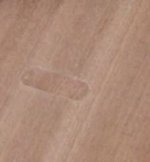This plate is designed to deal with moisture swelled dominoes - not dominoes from,scratch. I’ll do a video of it in action next week but keep your sandpaper, razor knife, hand plane close at hand.
You are using an out of date browser. It may not display this or other websites correctly.
You should upgrade or use an alternative browser.
You should upgrade or use an alternative browser.
Gadget - If you build it, they will....
- Thread starter ChuckS
- Start date
Cheese
Member
What you're up against is that the Domino will never center itself in the guide plate because of its shape. A round dowel will tend to center itself but an oblong form will not. You can see that sometimes both ends of the Domino come out wonky as it travels through the guide plate while moving from side-to-side.
As Peter noted, if the Domino has swelled just a couple of thousandths from moisture, then you may be ok, but anything more than a few thou and you have that side-to-side motion.
[attachimg=1]
As Peter noted, if the Domino has swelled just a couple of thousandths from moisture, then you may be ok, but anything more than a few thou and you have that side-to-side motion.
[attachimg=1]
Attachments
Crazyraceguy said:woodbutcherbower said:I'm personally not a Domino user, simply because I don't do enough of the type of work the machine obviously excels at. But if I ever did buy one, I'd also buy ready-made Festool dominos. This just seems like a whole bunch of goofing around with no real benefit - and to be honest, I don't have time for that.
Snip. Most people don't know that you can get them in larger quantities than the clear plastic retail boxes. They sell a "case quantity" type box that is 6 times the amount of the little retail units.
Snip.
I found that out only after having "wasted" a lot of money on the smaller packs. I now use the plastic cases to store the tenons taken out from the bulk pack boxes.
luvmytoolz
Member
ChuckS said:Crazyraceguy said:Snip. Most people don't know that you can get them in larger quantities than the clear plastic retail boxes. They sell a "case quantity" type box that is 6 times the amount of the little retail units.
Snip.
I found that out only after having "wasted" a lot of money on the smaller packs. I now use the plastic cases to store the tenons taken out from the bulk pack boxes.
In OZ the large systainer starter sets with the cutters is the only way even close to economical to buy dominos and cutters. For the DF500 for example, the domino starter set comes with the full set of cutters and a fairly massive amount (over 1000) of dominos. To buy the cutters separately on their own is around $450AUD, but I've bought the starter set for as little as $230AUD.
Don't get me started on the DF700 costs though, way more coin!!
Packard
Member
I don’t use dominoes, but the fluted dowels and biscuits both need to be kept in air tight jars to keep them from absorbing moisture and swelling.
I don’t see why you would want to make your own dominoes. It would lose that swelling factor that makes for the really tight joints. Is it just to save money? If so, that seems like a lousy trade off. Save a little money, end up with looser joints.
I don’t see why you would want to make your own dominoes. It would lose that swelling factor that makes for the really tight joints. Is it just to save money? If so, that seems like a lousy trade off. Save a little money, end up with looser joints.
I think a LOT of people are mis-guided or just plain ol' mistaken about why dominos are so hard to "test" fit.
It's because of those knife edge ridge(s) on the thin side of the domino, not because the whole domino has bloated because of moisture absorption.
With this in mind, that trim plate becomes an over complicated solution ( or worse ) to remove those edges. A block plane, piece of sandpaper, or a belt sander if you're into a production line set up - are much better options that are faster & cheaper. And you likely already have some lying about. Let's assume for a second your dominos are fat and bloated and they've grown in thickness (not likely) but hey, I'll play along............the trim plate isn't going to shave down the two broad faces of the domino anyway. Even if it did, the effort expended would immense, and the resulting finish so horrible as to make those earlier pictures look like the work of Maloof or Krenov.
Chuck nailed it.........................."solution looking for a problem "
It's because of those knife edge ridge(s) on the thin side of the domino, not because the whole domino has bloated because of moisture absorption.
With this in mind, that trim plate becomes an over complicated solution ( or worse ) to remove those edges. A block plane, piece of sandpaper, or a belt sander if you're into a production line set up - are much better options that are faster & cheaper. And you likely already have some lying about. Let's assume for a second your dominos are fat and bloated and they've grown in thickness (not likely) but hey, I'll play along............the trim plate isn't going to shave down the two broad faces of the domino anyway. Even if it did, the effort expended would immense, and the resulting finish so horrible as to make those earlier pictures look like the work of Maloof or Krenov.
Chuck nailed it.........................."solution looking for a problem "
Cheese
Member
Packard said:I don’t see why you would want to make your own dominoes. It would lose that swelling factor that makes for the really tight joints. Is it just to save money? If so, that seems like a lousy trade off. Save a little money, end up with looser joints.
If you're using the Domino as a decorative element in a joint you may want to contrast it with a particular color of wood like this.
[attachimg=1]
Also, biscuits and Dominos are constructed differently. Biscuits are made from compressed wood fibers while Dominos are made from actual wood stock. While both products need to be glued in place, biscuits tighten joints only by expanding, on the other hand, Dominos tighten joints by being a snug fit and then, the added glue and expansion is a bonus round.
Attachments
This discussion presents itself to the potential of a possible new product: cnc milled domino caps made of common wood species that are in the exact shape of the mortises. They don't have to be in the full length of the dominoes as their use is just to cover the exposed ends.
Someone who owns an Epilog laser engraving machine may be able to do some batches to sell?
Someone who owns an Epilog laser engraving machine may be able to do some batches to sell?
squall_line
Member
xedos said:I think a LOT of people are mis-guided or just plain ol' mistaken about why dominos are so hard to "test" fit.
It's because of those knife edge ridge(s) on the thin side of the domino, not because the whole domino has bloated because of moisture absorption.
With this in mind, that trim plate becomes an over complicated solution ( or worse ) to remove those edges. A block plane, piece of sandpaper, or a belt sander if you're into a production line set up - are much better options that are faster & cheaper. And you likely already have some lying about. Let's assume for a second your dominos are fat and bloated and they've grown in thickness (not likely) but hey, I'll play along............the trim plate isn't going to shave down the two broad faces of the domino anyway. Even if it did, the effort expended would immense, and the resulting finish so horrible as to make those earlier pictures look like the work of Maloof or Krenov.
Chuck nailed it.........................."solution looking for a problem "
And if the only need is to test/dry fit, and a person test/dry fits on a regular basis, it may be better to just sand down a set of 20 or 50 dominoes to "loosen" them up a little and mark them as test-fit only.
Packard
Member
ChuckS said:This discussion presents itself to the potential of a possible new product: cnc milled domino caps made of common wood species that are in the exact shape of the mortises. They don't have to be in the full length of the dominoes as their use is just to cover the exposed ends.
Someone who owns an Epilog laser engraving machine may be able to do some batches to sell?
To test the market, CNC would make sense. But for production, a milling head to make continuous lengths and then cut to length would be far more cost effective.
From my conversations with “civilians” (that is not “us”, woodworkers), there is little appreciation for exposed joinery. Indeed, for some it looks untidy, much like the exposed waistband from your Jockey shorts showing or a sexy blouse with the bra straps exposed.
About 50 years ago, I made shelves from 2” x 12” redwood (cheaper back then) with four sided “boxes” joined with 3/4” birch (or maybe poplar) dowels through drilled to fasten the butt joints. I thought it looked cool back then (and it was robustly strong). But nowadays, I much prefer hidden joinery. It is, in my opinion, a cleaner and more elegant look.
But if you are building to satisfy your own design aesthetics, then maybe exposed dominoes is the answer. Ask your significant other (if she or he is not a woodworker) which they prefer—exposed or hidden fastener. You might be surprised.
If exposed joinery was desirable, why would we always fill nail holes and and use drywall compound over drywall screws? We could use cup washers with the drywall screws and be done with it.
Note: I did a small room’s wall with ship lap and a woodworker friend faulted me for filling all the nail holes. He said it did not look “authentic” without the nail holes.
Exposed joinery, like a lot of other furniture design features, is in the eye of the beholder. Sam Maloof (rockers), Tage Frid (three-legged stools), Krenov (cabinet stands) and Nakashima (chairs) -- whose works I admire-- had used it sparingly in their pieces. When it comes to dominoes, I've never used exposed tenons except for shop builds as I don't like the gaps left on the ends.
[attachimg=1]
The primary use of hardwood domino caps, if commercially available, for me would be to hide/cover mistakes:
[attachimg=2]
[attachimg=1]
The primary use of hardwood domino caps, if commercially available, for me would be to hide/cover mistakes:
[attachimg=2]
Attachments
Packard
Member
I use through dowels frequently, but only on applications where they don’t show.
For example, I use them on face frame cabinets to strengthen the vertical panel to horizontal panel joints.
I use confirmats to “clamp” the joint, then i through drill and glue in dowels. The dowels provide racking strength and the confirmats hold thins together while the glue dries. But, those cabinets get end panels applied or they are hidden. No exposed joinery.
For example, I use them on face frame cabinets to strengthen the vertical panel to horizontal panel joints.
I use confirmats to “clamp” the joint, then i through drill and glue in dowels. The dowels provide racking strength and the confirmats hold thins together while the glue dries. But, those cabinets get end panels applied or they are hidden. No exposed joinery.
That looks interesting. I may pick one up.ChuckS said:A solution looking for a problem to solve?https://dfmtoolworks.com/products/a2-domino-trim-plate
Cheese said:While both products need to be glued in place
If dominos are being used as an alignment aid then gluing is unnecessary unlike if Dominos are being used as loose tenons.
Similar threads
- Replies
- 6
- Views
- 474
- Replies
- 6
- Views
- 574




